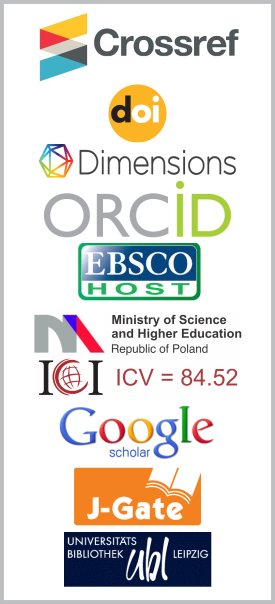Saline Water Intrusion: Its Management and Control
DOI:
https://doi.org/10.26713/jims.v9i2.748Keywords:
Saltwater intrusion, Potability of water, Techniques for control, Management of groundwater, Recharge rateAbstract
This paper brings to the fore techniques for proper management of saline water intrusion in coastal region because of the hardship its negligence bring upon the public that rely on it for livelihood. Groundwater remains the main source of quality and adequate water supply in the world over from which we get water for domestic, agricultural and industrial usage. One of the factors affecting the quality of water from this source is saline water intrusion, especially in coastal aquifers. This problem affects the potability of the water and the population that depends on it. Therefore, due to the aforementioned problem, measures must be put in place in order to adequately manage and control saline water intrusion so as to protect the dependent population from untold hardship that may result in near future.Downloads
References
B. Adebo, Assessment of saline intrusion in Lagos coastal aquifer, International Archive of Applied Sciences and Technology 3 (2012), 23 – 28.
I.A. Al-Abdoulhadi, H.A. Dinar, G. Ebert and C. Buttner, Effect of salinity on leaf growth, leaf injury and biomass production in date palm, Indian Journal of Science and Technology 4 (11) (2011), 1542 – 1546.
P.M. Barlow, Groundwater in freshwater-saltwater environments of the Atlantic Coast, U.S. Geological Survey, Circular 1262 (2003).
R.J. Colon-Rivera, R.A. Feagin, J.B. West, N.B. Lopez and R.J. Benitaz-Joubert, Hydrological modification, saltwater intrusion and trevwater use of a pterocarpusofficinalis swamp in Puerto Rico, Estuarine, Coastal and Shelf Science 147 (2014), 156 – 169.
A. Das, D.K. Bandopadhyay, K.J. Jee and I.R. Chowdhury, Hydrogeochemistry of groundwater in Chandanpur area of Odisha, India, International Journal of Geomatics and Geosciences 3 (2015), 448 – 458.
C. Mustatea, N. Singhal and G. S. De Costa, Salinity intrusion, its management and control: Future scenarios: Case of the Waiwhetu aquifer, in 33rd Congress of the International Association for Hydraulic Research, Vancouver, British Columbia, Canada (2009).
M.A. Eissa, H.H. Mahmoud, O. Shonakar-Stash, A. El-Shiek and B. Parker, Geophysical and geochemical studies to delineate sea water intrusion in Bagoush area, northwestern coast, Egypt. Journal of African Earth Sciences 121 (2016), 365 – 381.
G. Felisa, V. Ciriello and V. Di Federico, Saltwater intrusion in coastal aquifers: a primary case study along the Adriatic coast investigated within a probabilistic frame work, Water 5 (2013), 830 – 1847.
J.Y. Ghislain, F. Roger, W. Joseph, G.E. Emmanuel and M. Ghislain, Evaluation of groundwater suitability for domestic and irrigational purposes: A case study from Mingoa River Basin, Yaounde, Cameroon, Journal of Water Resources and Protection 4 (2012), 285 – 293.
M.S. Hussain and A.A. Javadi, Assessing impacts of sea level rise on seawater intrusion in coastal aquifer with sloped shoreline boundary, Journal of Hydro-Environment Research 11 (2016), 29 – 41.
R. Jahanshahi and M. Zare, Hydrochemical investigations for delineating salt-water intrusion into the coastal aquifer of Maharlou lake, Iranian Journal of African Earth Science 121 (2016), 16 – 29.
N. Kazakis, A. Pavlou, G. Vangemezis, K.S. Voudouris, G. Soulious, F. Pliakas and G. Tsokas, Seawater intrusion mapping using electrical resistivity tomography and hydrochemicaldata, an application in the coast area of eastern Thermaikos Gulf, Greece, Science of the Total Environment 543 (2016), 373 – 387.
K. Krupavathi and R.B. Movva, Sea water intrusion into coastal aquifers- concepts, methods and adoptable control practices, International Agricultural Engineering 2 (2016) (9), 213 – 221.
C.P. Kumar, Management of groundwater in salt water ingress coastal aquifers, Groundwater Modeling and Management 8 (2006), 540 – 560.
L. Lanbo, Saline water intrusion, Encyclopedia of Life Support Systems, Natural and Human Induced Hazards 2 (2016), 1 – 7.
A. Mahesha, Control of seawater intrusion through injection-extraction well system, Journal Irrigation Drain Engineer 22 (1996), 314 – 317.
M.I. Oladapo, O.B. Ilori and O.O. Adewoye-Oladapo, Geophysical study of saline water intrusion in Lagos municipality, African Journal of Environmental Science and Technology 8 (1) (2014), 16 – 30.
B.N. Priyanka and A. Mahesha, Parametric studies on saltwater intrusion into coastal aquifers for anticipated sea level rise, Aquatic Procedia 4 (2015), 103 – 108.
A. Rastogi, G.W. Choi and S.K. Ukarande, Diffused interface model to prevent ingress of seawater in multi-layer coastal aquifers, Journal Special Hydrology 4 (2004), 1 – 31.
G.A. Robinson, A.A. Ahmed and G.A. Hamil, Experimental saltwater intrusion in coastal aquifers using automated image analysis: application to homogeneous aquifer, Journal of Hydrology 538 (2016), 304 – 313.
J.C. Van Dam, Exploitation, restoration and management, Seawater Intrusion in Coastal Aquifers – Concepts, Methods and Practices, Kluwer Academic Publishers, Dordrecht, The Netherlands, 73 – 125 (1999).
A.D. Wenner and C.T. Simmon, Impact of sea-level rise on sea water intrusion in coastal aquifers, Physics and Earth Sciences 47 (2) (2009), 197 – 204.
X. Zeng, J. Wu, D. Wang and X. Zhou, Assessing the pollution risk of a groundwater source field at western Laizhou bay under seawater intrusion, Environmental Research 148 (2016), 585 – 594.
X. Zhou, A method of estimating the fresh water – salt-water interface with hydraulic heads in a coastal aquifer and its application, Geoscience Frontiers 2 (2011), 199 – 203.
Downloads
How to Cite
Issue
Section
License
Authors who publish with this journal agree to the following terms:- Authors retain copyright and grant the journal right of first publication with the work simultaneously licensed under a CCAL that allows others to share the work with an acknowledgement of the work's authorship and initial publication in this journal.
- Authors are able to enter into separate, additional contractual arrangements for the non-exclusive distribution of the journal's published version of the work (e.g., post it to an institutional repository or publish it in a book), with an acknowledgement of its initial publication in this journal.
- Authors are permitted and encouraged to post their work online (e.g., in institutional repositories or on their website) prior to and during the submission process, as it can lead to productive exchanges, as well as earlier and greater citation of published work.




